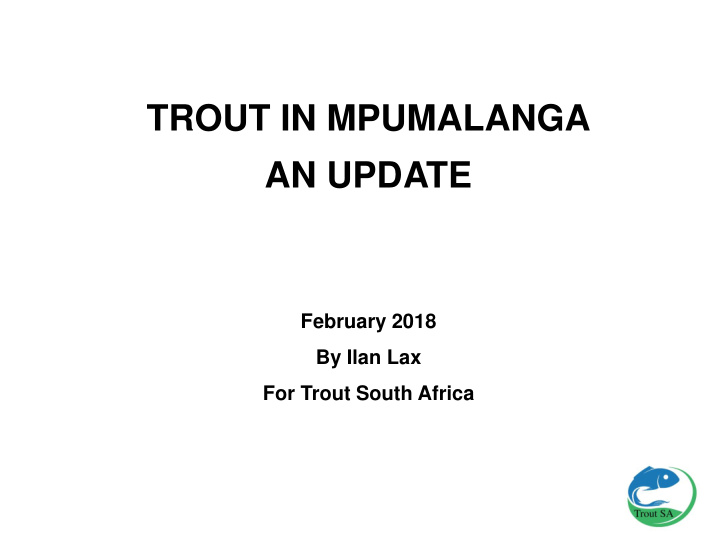



TROUT IN MPUMALANGA AN UPDATE February 2018 By Ilan Lax For Trout South Africa
Overview This presentation will cover: Where have we come from? What are current developments? Some thoughts on the next steps.
Brief background FOSAF develops a positive approach to demonstrating the value of flyfishing in SA. Ongoing discussions with and assistance to provincial conservation agencies. Development of FOSAF principles and policies incl. trout position paper. Numerous submissions to DEA and various provincial conservation agencies on the status of trout. Prior mapping exercises.
Where have we come from? (1) Phakisa Freshwater aquaculture part of Operation Phakisa Ocean Labs Conference in Durban - July 2014. Pragmatic enabling solutions found that comprise a “ win-win ” agreement: 1. Where trout already occur not be declared invasive. Regarded as “invasive” where trout do not occur but 2. could. 3. Self-regulation as far as possible through DAFF and TSA. 4. Introductions require risk assessments - balancing significant risks against possible benefits.
Where have we come from? (2) TROUT SA is established: as an agricultural commodity group recognised by DAFF as a key representative of the trout value chain. with regional subgroups like Mpumalanga Trout Association & others in other provinces. a member of Aqua SA and through this Agri SA and BUSA.
Where have we come from? (3) Post Phakisa Mapping Process Kirstenbosch meeting (August 2014) discusses practical implementation of Phakisa agreement. Agreed to map “where trout occur”. Fern Hill meeting (October 2014) to identify “where trout occur”. Dr Ivey (SANBI) engages as facilitator with stakeholders, DEA & Provinces for input by the trout value chain. (Late 2014 to Late 2015) Process ends in stalemate and escalation to DGs & Phakisa Office.
Where have we come from? (4) FOSAF, TroutSA, the DGs (& support teams) and Phakisa Office meet in Cape Town (Feb 2016). The meeting discusses all issues including mapping, legislation, provincial concurrence and creating an enabling environment. The meeting confirms the Phakisa win-win was approved by MINMEC and that provinces have been consulted and thus need to get on board. The April 16 mapping meeting cancelled for further consultation.
Where have we come from? (5) Despite problems in some provinces, the mapping process continues for much of the year and is completed successfully. A different version of the regulations is eventually released without the agreed consultation or the required agreed information. Maps released in different format causing confusion. Further meeting cancelled. (Jan 17) DEA renege on the agreed process and publish new regulations. (Mid 17) Further escalation by Aqua SA to Phakisa Steering Committee (Late 17)
Current Scenario (1) No movement on the mapping, AIS regulations or other aspects of the process. TSA becomes aware of new NEMBA Bill. Its implications are potentially problematic. Its thus clear that DEA negotiated in bad faith and had no intention to implement the win-win achieved at Phakisa. 2015 NEMLA Bill is now before Parliament. TSA & FOSAF made submissions expressing concerns.
Current Scenario (2) The NEMBA Bill circulating inside government but not yet published for consultation reflects the intentions and approach of DEA. Both statutes will place biodiversity, including genetic resources, under the increased discretionary control of the Minister. This will affect property rights and people’s livelihoods as well as other human rights that depend on what is presently a relatively unregulated right to possess and use biological resources.
Current Scenario (3) NEMBA has failed as reported by its own evaluation exercise. DEA has demonstrated: o a top down tick box approach that fails to take people’s views into account; o an inability to follow its own laws; o A strong command control based approach rather than an more compliance and incentives approach (penalties doubles to R20mil or 20 years); o Heavy handed discretion based actions that are open to abuse by officials. Both statutes will increase these concerns rather than address them and the reasons for failure.
Current Scenario (3) FOSAF and then TSA have complained that NEMBA is a law that was drafted, promulgated and is being implemented without an formally adopted policy. There is thus no real guide on how it should be applied. The way to find common ground that unites us in our diversity is to engage in a proper public consultative policy making process that is informed by the constitutional values and human rights as expressed in the Bill of Rights and the NEMA Principles before trying to make new laws.
Way forward Communicate and meet with the range of partner organisations like AGRI SA, BUSA, other like minded commodity groups , stakeholders & partners to discuss the new developments. Hopefully make them aware of the issues, risks and implications. Find common ground & get buy-in on solutions and how to take this forward.
THANKS FOR LISTENING
Recommend
More recommend